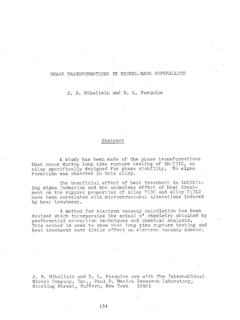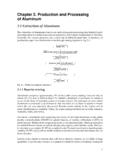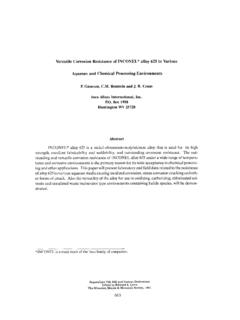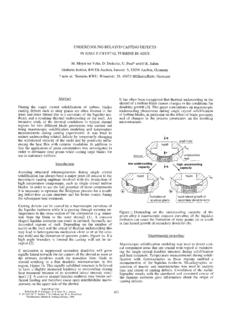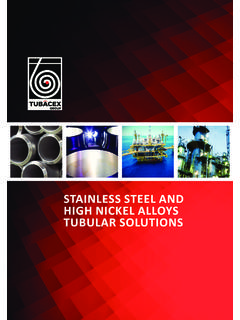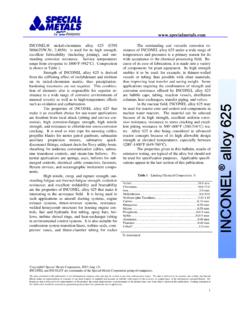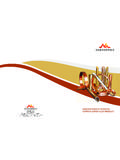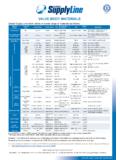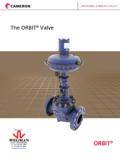Transcription of The Invention and Definition of Alloy 625
1 THE Invention AND Definition OF Alloy 625 H. L. Eiselstein and D. J. Tillack lnco alloys International, Inc. P. 0. Box 1958 Huntington, WV 25720 ABSTRACT The filing of a patent application for Alloy 625 on January 24, 1962, marked the culmination of nearly a decade of research on the basic Ni-Cr-Mo-Nb Alloy system. This paper describes the research and development effort that resulted in the Invention of Alloy 625, how some of the problems that were encountered along the way were solved and how numerous variants of the Alloy were developed. One of the remarkable aspects of the research effort is that it also resulted in the Invention of Alloy 718.
2 Superalloys ,625 and Various Derivatives Edited by Edward A. Lmia The Minerals, Metals & Materials Society, 1991 1 Introduction The development of INCONEL@ Alloy 625 (UNS N06625) was started in the 1950s to meet the then-perceived demand for a high-strength main steam-line piping material. After several years of discovering how various elements affected the properties and fabricability of the Alloy system, a patent application was submitted on January 24, 1962. Patent #3,160,500 was issued to H. L. Eiselstein and J. Gadbut on December 8, 1964. The present composition for Alloy 625 is listed in Table I.
3 Table I. INCONEL Alloy 625 Typical Composition (%) Ni Cr MO Nb Fe c Si Al Ti Mn S 61 9 2 .05 .20 .20 .20 .20 .OOl The story of the Invention and Definition of Alloy 625 reflects the triumphs, frustrations and surprises that often accompany the stimulating world of the metallurgical R&D laboratory. Genesis - The Early Work In the 1950s there seemed to be an opportunity developing for a main steam-line material for super critical steam power plants. One such power facility, the Eddystone plant near Philadelphia, was being built using 316 stainless steel. This plant used 649 C (1200 F) steam at MPa (2000 psi).
4 The product goals for our development were weldability, high creep resistance, fabricable into tubing, non-agehardening, and otherwise have attractive ASME Boiler Code design properties, This was to be, what we called, a matrix stiffened Alloy , with a nickel-based composition, Along the way to a product our goals were modified considerably, except for weldability. Work had already been done in the 1950s on the strengthening effects of various amounts of the common major alloying elements, , chromium, molybdenum, niobium* *, aluminum, and titanium in an INCONEL Alloy 600 base.
5 (INCONEL Alloy X-750, which is strengthened by titanium and aluminum, had been around for several years,) The strengthening effects of these elements one at a time were not impressive. So it was decided to use molybdenum and niobium in combination with varying amounts of nickel. Because an Alloy goal was metallurgical stability, tensile samples of each Alloy were given a simple aging treatment, such as 704 C (1300 F) for 16 hours, and tested at room temperature. It was hoped that these tests would indicate any tendencies for age hardening or embrittlement, which they did in a spectacular way.
6 The net result is shown in Figure 1 .(I) These results delayed the development of Alloy 625 and started one which resulted in INCONEL Alloy 718. A patent application for Alloy 718 was filed on November. 13, 1958, and the patent was issued on July 24, 1962 (#3,046,108). @lNCONEL is a trademark of the lnco family of companies. **Note: In all cases throughout this paper, the percent niobium is intended to be interpreted as niobium + tantalum, with the tantalum comprising less than 10% of the total niobium + tantalum content. 2 180 160 .= 140 B 0 120 b WI 2 100 $;: % 80 d 60 40 Nb + 2T MO Annealed / Nb c 3% Nb c 3% MO MO Annealed Nb + 3% MO Annealed and Aged Nb + 2% MO Annealed and Aged 1200 1100 1000 2 900 3 5l 800 5 b ' 700 f.
7 600 s 6 500 O ' . 400 . 300 20 30 40 50 60 70 80 % Nickel Figure 1. Effect of Ni and Nb Content on Room Temperature Yield Strength of An- nealed and Aged Ni, Cr, Nb, MO, Al, Ti, Bal. Fe alloys . Annealed and Aged = 1038 C (1900 F)/l hr, WQ + 677-732 C (1250-1350 F)/16 hrs, AC. Annealed = 1038 C (1900 F)/l hr, WQ + no aging. After the hiatus caused by the Alloy 718 development, the market for a nickel-based Alloy for super critical steam had vanished. The Alloy composition of the matrix-stiffened Alloy , code named MS-2, when development efforts resumed was approximately 60Ni, , 3Nb, 2M0, OJAI, and balance Fe.
8 In the annealed state this Alloy was a little harder than Alloy 600 and could have been easily fabricated into all standard mill products. Then it was suggested that the Alloy could more readily compete with already established alloys in the marketplace if it had higher room temperature tensile properties. Fortunately for the Alloy 625 development, the elements chromium and molybdenum that were used to increase room temperature strength also greatly increased the corrosion resistance. This change in composition altered the course of development of this Alloy and increased its marketing opportunities.
9 Because of the higher strength there were problems in producing some products, but weldability was not impaired. The chromium and molybdenum contents were raised to their current levels of 22% and 9% respectively. Effects of Elements on Strenath By using factorial experiments the appropriate levels of niobium, molybdenum, aluminum, titanium and chromium were determined. The niobium solubility in the Alloy appeared to be about and increased with decreasing MO + Cr content. The aluminum solubility was determined to be about 3 60 30 40 50 60 70 NI - Wt. % Figure 2.
10 Effect of Nickel on 1000 hr 649 C (1200 F) Rupture Strength Annealed 1038 C (1900 F) for 1 Hr. Note: Balance of Composition: 13-21 Cr, Nb, 2-3 MO, . Al, . Ti, .2 Si, .2 Mn, . C, Bal Fe. 1000 The effect of nickel on the 1200 F 140 stress-rupture strength of annealed 625, as shown in Figure 2, shows a 5 12 peak around 57%. Figure 3 demon- a ANNEALED & AGED g 100 strates only a slight matrix stiffening ef- 0 feet of niobium (the annealed curve) ; and a significant increase in annealed 5 80 ol + aged yield strength beyond about 3% 2 niobium. Alloy 718 had lower solubility 5 so for niobium, and consequently higher $ annealed + aged strength, due to lower 2 4o nickel and higher aluminum and tita- 2 nium content.
